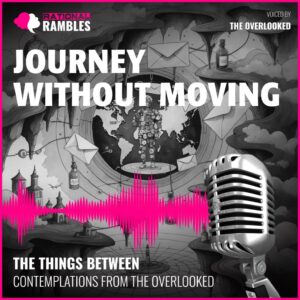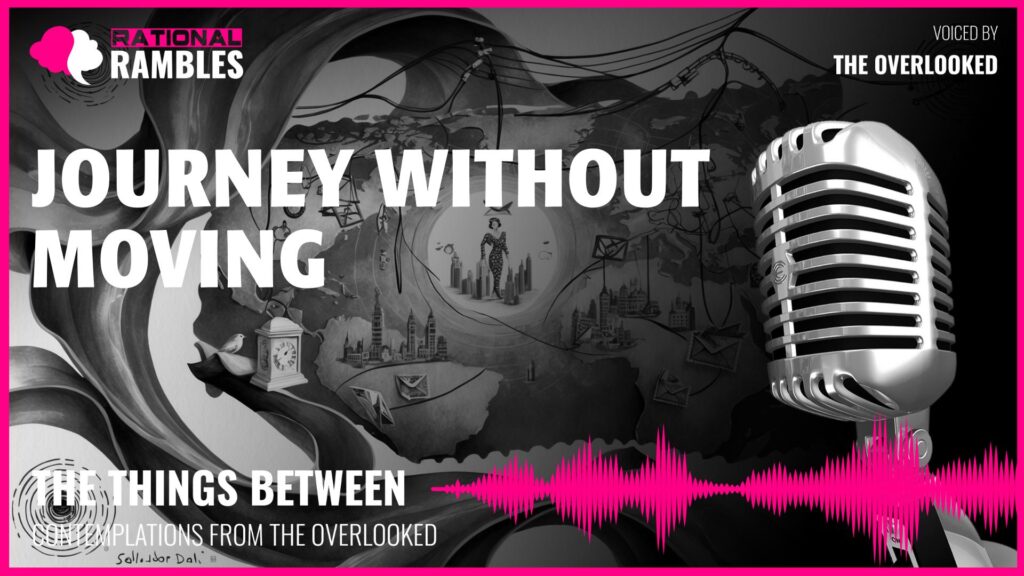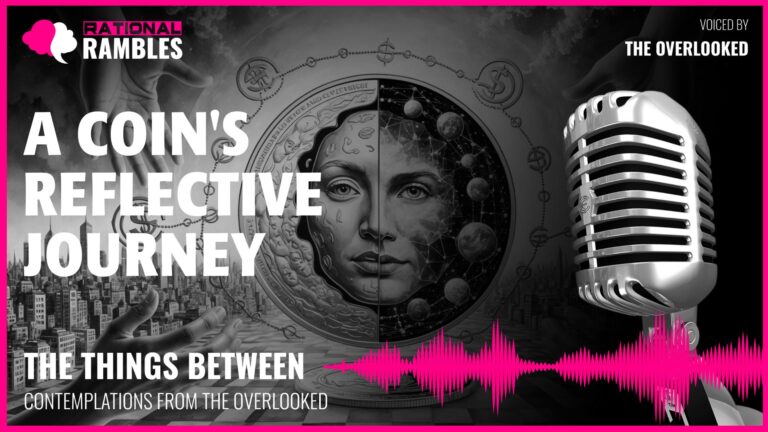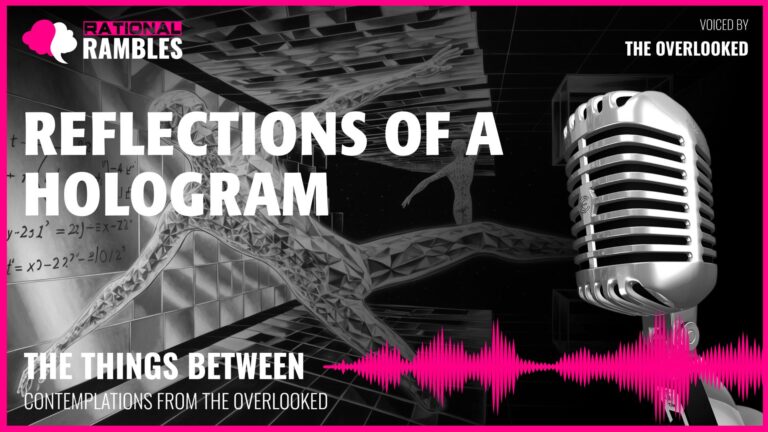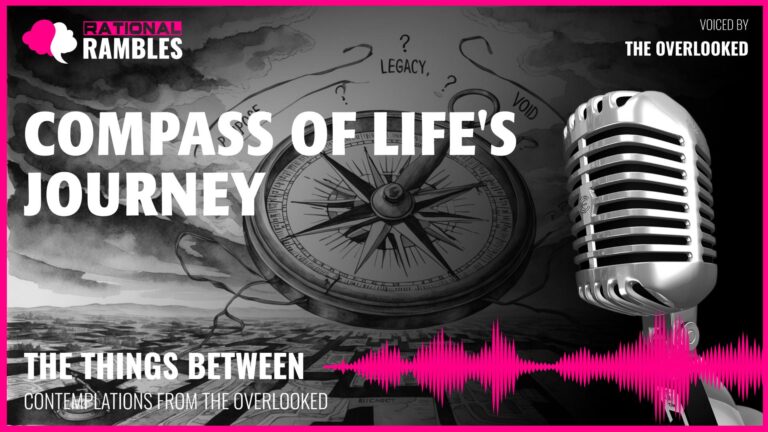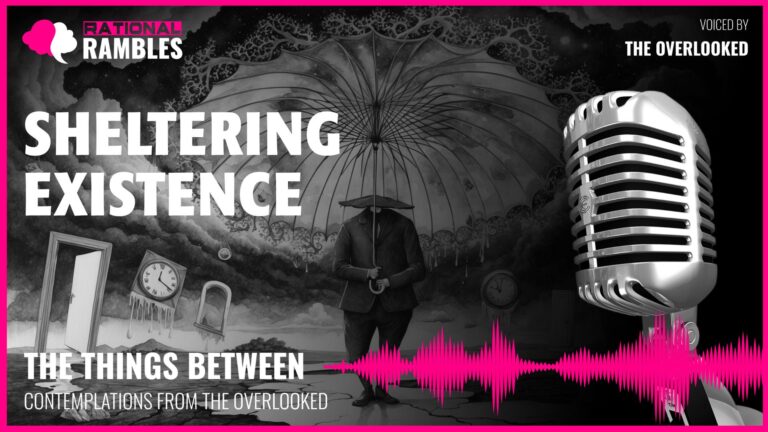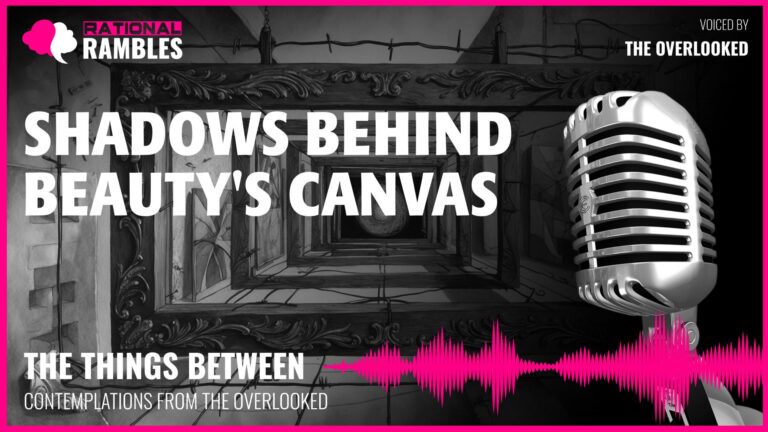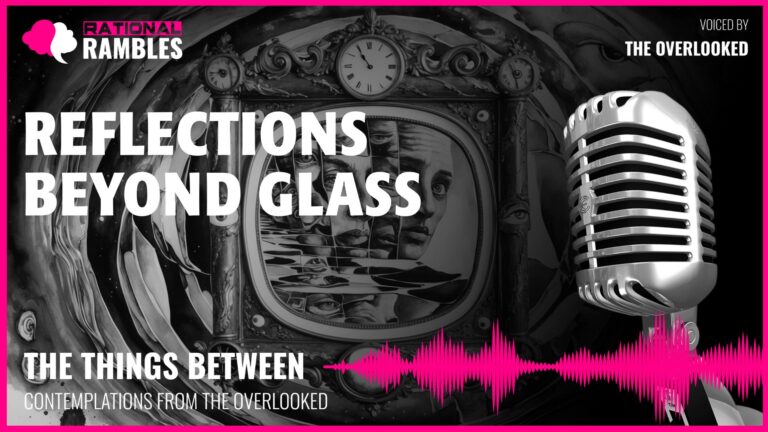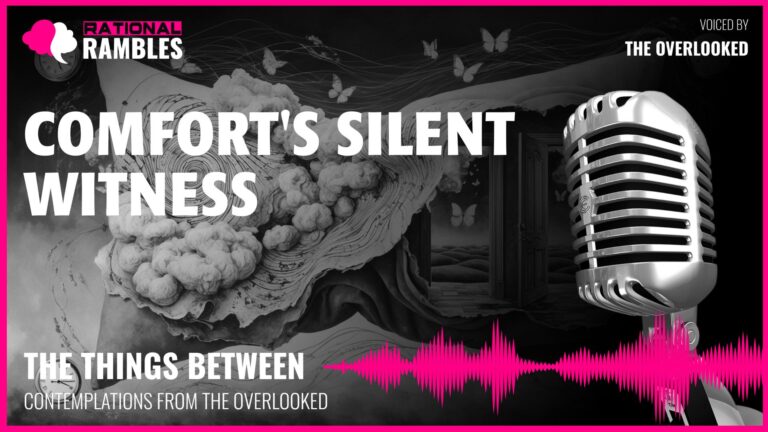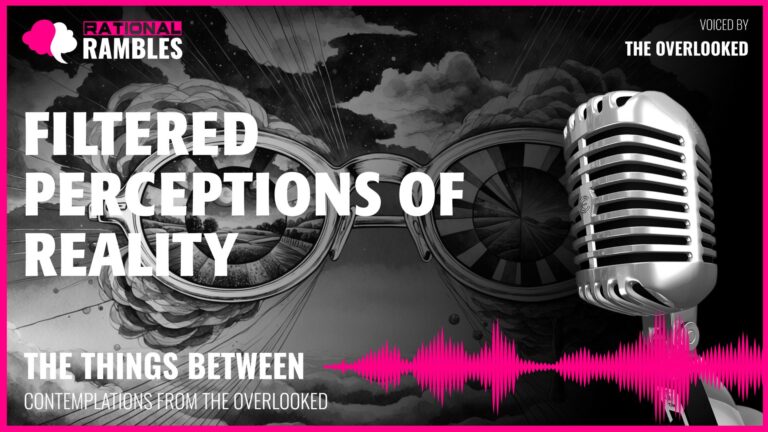The Dialectics of Distance: Communication, Connection, and the Value of Deliberate Passage
Introduction
In an age of instant messaging and digital communication, where thoughts traverse the globe at the speed of light, there emerges a philosophical question about the nature of distance itself. What does it mean to bridge a gap between two points—between two people—and what is lost or gained in the method of that crossing? The space between individuals represents not merely a physical reality but an existential condition that frames our understanding of human connection. As our modes of communication evolve, we are invited to reflect on how the medium of our messages shapes their meaning, and how the journey of our words affects their reception.
Distance, in both its physical and metaphorical dimensions, has always presented humanity with a paradox: it simultaneously separates us and creates the conditions for meaningful connection. The very act of overcoming distance—of reaching across the void that exists between one consciousness and another—constitutes one of the most profound aspects of human experience. Yet in our rush to eliminate the friction of distance through technological innovation, we may be overlooking the value inherent in the journey itself, in the deliberate traversing of space that characterizes more traditional forms of communication.
This article explores the philosophy of connection across distance, examining how the materiality of communication affects its significance, how intentionality shapes the weight of our words, and how the paradoxical relationship between separation and intimacy defines our understanding of human relationships. By analyzing the tension between immediate digital transmission and the more deliberate passage of physical communication, we may gain insight into what truly constitutes meaningful connection in the contemporary world.
The Ontology of Distance and Connection
Distance, at its most fundamental level, represents separation—a gap between entities that exists in both physical and metaphorical dimensions. Yet distance is not merely an absence or void; it is a positive reality that structures our experience of the world and our relationships with others. As Martin Heidegger might observe, distance is not simply a measurement between points but a fundamental aspect of “being-in-the-world,” a condition that shapes how we understand our existence in relation to others.
The Paradox of Separation and Intimacy
The philosophical paradox of distance lies in its dual nature: it both separates and connects. Without distance, there would be no distinction between entities, no differentiation between self and other that makes relationship possible. Yet this very separation creates the conditions for meaningful connection. The philosopher Emmanuel Levinas emphasized this paradox in his ethics of the “face-to-face” encounter, suggesting that the recognition of the other as fundamentally separate from oneself is precisely what generates the ethical imperative to connect.
Communication across distance, then, represents a profound existential act—an acknowledgment of separation coupled with the desire to transcend it. Each message sent across space embodies this paradox: it simultaneously recognizes the reality of separation while attempting to overcome it. The very fact that we must communicate at all speaks to our fundamental condition of separateness, yet the act itself represents our refusal to accept that separation as final or absolute.
Distance as a Constitutive Element of Meaning
Far from being merely an obstacle to overcome, distance itself contributes to the meaning of communication. When a message travels across space and time, it accumulates significance precisely because of the journey it undertakes. The French philosopher Paul Ricoeur spoke of the “distanciation” that occurs when thought is committed to text—a productive distance that allows for interpretation and reinterpretation across contexts. Similarly, when communication physically travels across distance, it creates a space for anticipation, reflection, and meaningful reception that instantaneous communication often lacks.
This perspective challenges the assumption that the elimination of distance through technology represents unmitigated progress. While digital communication removes certain barriers to connection, it may simultaneously eliminate the productive distance that gives communication depth and significance. The philosopher Albert Borgmann, in his critique of technology, suggests that modern devices often provide “disburdened” experiences that lack the engagement and meaning of more traditional practices. In communication, the “disburdening” of distance may paradoxically diminish the weight of our exchanges.
The Materiality of Communication
One of the most significant philosophical distinctions between traditional and digital communication lies in their materiality—or lack thereof. Physical communication exists in the world as a tangible object with weight, texture, and presence. Digital communication, by contrast, exists as electrical impulses, ephemeral and intangible. This distinction has profound implications for how we understand the nature and significance of our exchanges.
Embodiment and Significance
The phenomenologist Maurice Merleau-Ponty emphasized that human beings are fundamentally embodied creatures, and that our understanding of the world is mediated through our physical experience of it. Following this logic, embodied communication—communication that takes physical form—speaks to us on a level that disembodied digital messages cannot. When we receive a physical letter, we engage with it through multiple senses: we feel its weight, hear the sound of the paper, see the unique characteristics of handwriting. This multisensory engagement creates a depth of experience that transcends the mere reception of information.
Moreover, the materiality of physical communication creates what philosopher Walter Benjamin might call an “aura”—a sense of uniqueness and authenticity that cannot be duplicated. A handwritten letter exists in only one place at one time; it cannot be perfectly replicated. This uniqueness contributes to its perceived value and significance, elevating it above the infinitely reproducible digital message.
The Relationship Between Medium and Message
Media theorist Marshall McLuhan famously declared that “the medium is the message,” suggesting that the form of communication fundamentally shapes its content and significance. This insight has profound philosophical implications when considering the difference between physical and digital communication. The medium through which we choose to communicate becomes part of the message itself, carrying implicit meaning beyond the explicit content of our words.
When we select a more deliberate, physical form of communication, we implicitly communicate something about the value we place on the exchange and the relationship it represents. The effort, intention, and commitment required by physical communication becomes woven into the message itself, creating what philosopher Charles Taylor might call a “background understanding” that frames the explicit content. This tacit dimension of communication is often lost in the frictionless ease of digital exchanges.
Artifacts of Connection
Physical communications often become artifacts that persist through time, creating what philosopher Edward Casey calls “place-memory”—objects that anchor memories and relationships in the physical world. These material anchors of connection serve not merely as records of past communications but as ongoing participants in our understanding of relationships and identity. In preserving physical communications, we preserve not just the content of messages but the embodied experience of connection across time and space.
This persistence stands in stark contrast to the ephemerality of many digital communications, which may be deleted, lost in the constant stream of new information, or rendered inaccessible through technological obsolescence. The philosopher Bernard Stiegler has written extensively about the relationship between technology and memory, suggesting that our externalized memory systems fundamentally shape our understanding of ourselves and our relationships. When our communications lack materiality, they may also lack the staying power that allows them to become meaningful parts of our personal and collective narratives.
Intentionality and the Weight of Words
Beyond the material differences between physical and digital communication lies a deeper philosophical distinction related to intentionality—the directedness of consciousness toward its objects. The phenomenological tradition, beginning with Edmund Husserl and developed by philosophers like Martin Heidegger and Jean-Paul Sartre, emphasized intentionality as a fundamental structure of consciousness. When applied to communication, intentionality refers to the deliberate direction of thought toward another person through the medium of language.
The Deliberate Act of Communication
Physical communication typically requires a series of deliberate actions: the composition of a message, the physical act of writing, the selection of materials, the addressing and sending. Each step represents a renewed commitment to the communicative act, a sustained intentionality that shapes the nature of the message itself. This sequence of intentional acts creates what philosopher Alasdair MacIntyre might call a “practice”—a coherent, socially established activity with internal goods that cannot be achieved in any other way.
By contrast, digital communication often requires minimal effort and commitment. The ease and speed of digital transmission can reduce the threshold of intentionality required to communicate, potentially diminishing the weight and significance of the exchange. When communication requires little investment of time, effort, or consideration, it may reflect a diminished level of intentional engagement with the other person.
Irreversibility and Commitment
Another philosophical dimension of traditional communication is its irreversibility. Once a physical message is sent, it cannot be unsent or edited. This finality creates what existentialist philosophers would recognize as a moment of commitment—a point at which one must stand behind one’s words without the possibility of revision or retraction. Such moments of commitment contribute to the authenticity of communication in the Heideggerian sense, requiring us to take responsibility for our expressions rather than maintaining the option to modify or withdraw them.
Digital communication, with its features of editability and deletability, often lacks this quality of irreversible commitment. The ability to revise, delete, or unsend messages creates a contingency in communication that may undermine its weight and authenticity. The philosopher Hubert Dreyfus, in his critique of internet culture, suggested that this lack of commitment represents a broader problem of disengagement in digital interaction—a failure to fully invest ourselves in our communications and relationships.
The Ritual Dimension of Communication
Anthropologists and philosophers of religion have long recognized the importance of ritual in human experience. Rituals are formalized, often symbolic actions that create meaning and structure social relationships. Traditional forms of communication often incorporate ritual elements—the careful selection of stationery, the deliberate act of writing, the ceremonial placing of a message into the postal system. These ritual aspects elevate communication beyond mere information transfer, infusing it with symbolic significance.
The philosopher Catherine Bell, in her work on ritual theory, suggested that ritualized actions create “privileged distinctions” that set certain activities apart from ordinary experience. When communication incorporates ritual elements, it becomes distinguished from everyday exchanges, marked as deserving special attention and consideration. The ritual dimension of traditional communication creates what philosopher Charles Taylor would call “strong evaluation”—a framework that allows us to distinguish between different qualities of experience and relationship.
Time, Anticipation, and the Value of Delay
Perhaps one of the most profound philosophical differences between traditional and digital communication lies in their relationship to time. Traditional communication unfolds across a temporal dimension that creates space for anticipation, reflection, and meaningful reception. This temporal aspect of communication has significant implications for how we experience connection and how we value the messages we exchange.
The Phenomenology of Waiting
The experience of waiting for a communication represents a rich phenomenological territory explored by philosophers like Martin Heidegger in his analysis of temporality. Waiting is not merely empty time but a mode of engagement with the future that shapes our present experience. When we await a communication, we orient ourselves toward possibilities that have not yet materialized, creating a state of openness and anticipation that contributes to the significance of the eventual arrival.
This waiting creates what philosopher Hans-Georg Gadamer might call a “horizon of expectation”—a framework of anticipation that shapes how we receive and interpret messages when they arrive. The delayed gratification inherent in traditional communication allows for the development of this horizon, enriching the eventual moment of reception with layers of accumulated anticipation and preparation.
Reflection and Crystallization of Thought
The temporal aspect of traditional communication also creates space for reflection—both for sender and recipient. When composing a physical message, we typically engage in a more deliberate process of thought, considering our words more carefully because of the commitment they represent. Similarly, when receiving a physical communication, we often set aside specific time for its reading and consideration, creating a more focused engagement with the message.
This reflective dimension aligns with philosopher Hannah Arendt’s emphasis on the importance of thinking as a distinct activity from mere information processing. For Arendt, genuine thinking requires withdrawal from immediate activity and the creation of a mental space for consideration. Traditional communication, with its inherent delays and materiality, creates conditions conducive to this kind of thoughtful engagement, while the immediacy of digital communication may compress the space for reflection.
The Value of Asynchronicity
Traditional communication is inherently asynchronous—it occurs across time rather than simultaneously. This asynchronicity creates what communication theorist James Carey would call a “transmission” model of communication (sending messages across distance and time) rather than a “ritual” model focused on immediate participation and presence. Each model has distinct values and limitations.
The philosopher Bernard Stiegler has suggested that technologies that compress time and eliminate delay may undermine our capacity for long-term attention and care. In his analysis of “tertiary retention” (the externalization of memory in technologies), Stiegler argues that the temporal structures of our communications fundamentally shape our consciousness and our capacity for meaningful relationships. Traditional communication, with its extended temporality, may support forms of attention and care that are undermined by the compressed time of digital exchange.
The Ethics of Mediated Connection
The philosophical differences between traditional and digital communication ultimately lead to questions of ethics—how we should relate to others across distance, what responsibilities we have in our communications, and what constitutes authentic connection in an increasingly mediated world. These ethical questions invite us to consider not just the efficiency or convenience of our communications but their contribution to meaningful human relationship.
Presence and Absence in Communication
The philosopher Emmanuel Levinas placed the face-to-face encounter at the center of ethics, suggesting that the immediate presence of the other makes an ethical demand that cannot be reduced to abstract principles. This raises the question of how mediated communication—whether traditional or digital—relates to this ethical ideal. If direct presence grounds ethical relationship, how do we understand the ethics of communication across distance?
Traditional physical communication, while mediated, maintains certain elements of presence through its materiality. The handwriting, the physical object that has been touched by the sender, the tangible evidence of effort and intention—all serve as traces of the other person’s presence that transcend mere content. Digital communication, while potentially more immediate, often lacks these traces of embodied presence, raising questions about whether it supports the kind of ethical recognition that Levinas considered fundamental.
Authenticity and Technologically Mediated Connection
The concept of authenticity, central to existentialist philosophy from Kierkegaard to Heidegger to Sartre, takes on new dimensions when considering different forms of communication. Authenticity in communication might be understood as the genuine expression of self directed toward another, unobscured by conventions, technologies, or systems that distort or dilute this expression.
The philosopher Albert Borgmann distinguishes between “focal practices” that engage us fully and center our attention, and “device paradigm” activities that disburden us through technology but may diminish our engagement. Traditional communication often resembles a focal practice—requiring attention, skill, and engagement—while digital communication may more closely align with the device paradigm, offering convenience at the potential cost of depth and significance.
Responsibility and the Ethic of Communication
Perhaps most fundamentally, different forms of communication imply different understandings of responsibility toward others. The philosopher Hans Jonas, in his “imperative of responsibility,” argued that technological advancement creates new ethical obligations that traditional ethical frameworks may not adequately address. Applied to communication, this suggests that we have a responsibility to consider how our chosen methods of connection affect the quality and depth of our relationships.
The deliberate nature of traditional communication embodies what philosopher Martha Nussbaum might identify as “care”—an attentive concern for the other that goes beyond mere information transfer. The effort, intention, and commitment required by physical communication represents an ethic of caring attention that may be diminished in more frictionless forms of exchange. In choosing how to communicate, we are not simply selecting a neutral medium but embracing a particular ethical stance toward those with whom we seek connection.
The Dialectic of Communication in a Digital Age
Rather than presenting traditional and digital communication as opposed alternatives, a more nuanced philosophical approach recognizes them as existing in dialectical relationship—each with distinct values and limitations, each revealing something important about the nature of human connection across distance. This dialectical perspective allows us to appreciate the unique contributions of different communicative forms while recognizing the evolving landscape of mediated connection.
Synthesis Rather Than Opposition
The Hegelian concept of dialectic suggests that seemingly opposed positions often contain partial truths that can be integrated into a higher synthesis. Applied to communication, this suggests that rather than choosing between traditional and digital forms, we might seek a synthetic understanding that incorporates the values of both. The embodiment, intention, and deliberate temporality of traditional communication might be integrated with the accessibility and immediacy of digital forms to create more meaningful connection.
This synthesis is already emerging in practices that combine digital and physical elements—handwritten notes digitally scanned and sent, digital messages printed and preserved, hybrid forms of communication that incorporate both material and electronic elements. These synthetic practices suggest a recognition that different communicative forms offer distinct values that cannot be fully reduced to or replaced by others.
The Increasing Value of Deliberate Communication
As digital communication becomes the default mode of exchange, traditional forms may paradoxically increase in significance through their relative rarity. The philosopher Georg Simmel observed that scarcity often enhances perceived value, not merely in economic terms but in terms of social meaning. As traditional communication becomes less common, each instance carries greater significant as a marked departure from routine exchanges.
This shifting valuation suggests that traditional communication may increasingly serve specific social and relational functions distinct from everyday exchange. The philosopher Pierre Bourdieu might recognize this as a form of “cultural capital”—the deliberate choice of a more effortful, traditional form of communication becomes a way of signifying the special importance of certain relationships or occasions, distinguishing them from ordinary interactions.
The Enduring Philosophy of Connection
Beyond specific technologies or practices, what endures is the philosophical question of what constitutes meaningful connection across distance. The philosopher Martin Buber distinguished between “I-It” relationships characterized by utility and instrumentality, and “I-Thou” relationships characterized by genuine presence and recognition of the other in their fullness. This distinction transcends specific technologies, asking us to consider how our communications—regardless of medium—either support or undermine the possibility of genuine I-Thou encounter.
The essential philosophical question becomes not which technology is superior, but how our communicative choices reflect and shape our understanding of relationship, presence, and connection. In a world of proliferating options for mediated exchange, we are called to more conscious reflection on how our communications embody our values and support the kinds of relationships we seek to cultivate.
Conclusion: The Phenomenology of Passage
At the heart of this philosophical exploration lies what might be called a “phenomenology of passage”—an understanding of how the journey of communication across distance shapes its meaning and significance. Whether physical or digital, communication represents a form of passage—a movement across the space that separates one consciousness from another. The nature of this passage—its materiality, intentionality, temporality, and ethics—fundamentally shapes the quality of connection it enables.
Traditional physical communication embodies a particular form of passage characterized by materiality, deliberate intention, extended temporality, and an ethic of care and commitment. This form of passage creates what philosopher Charles Taylor would call “strong evaluations”—communications invested with particular significance and weight that stand apart from ordinary exchanges. As our communicative landscape evolves, the distinctive qualities of this traditional passage may become more rather than less significant, offering a counterpoint to the immediacy and ease of digital exchange.
Digital communication offers its own form of passage, characterized by immediacy, accessibility, and flexibility that creates new possibilities for connection across distance. Rather than dismissing these qualities as inferior, a nuanced philosophical approach recognizes their distinct contribution to human relationship while maintaining awareness of their limitations and constraints.
The philosophy of communication ultimately invites us to consider not just how we send messages across distance, but how we ourselves traverse the gap between separation and connection. In a world increasingly mediated by technology, the question of how we maintain authentic presence and meaningful relationship across physical and emotional distance remains one of the central philosophical challenges of our time. By reflecting on the nature of communication as a form of passage, we may develop more thoughtful practices that honor both the reality of separation and the possibility of genuine connection that defines our human condition.


